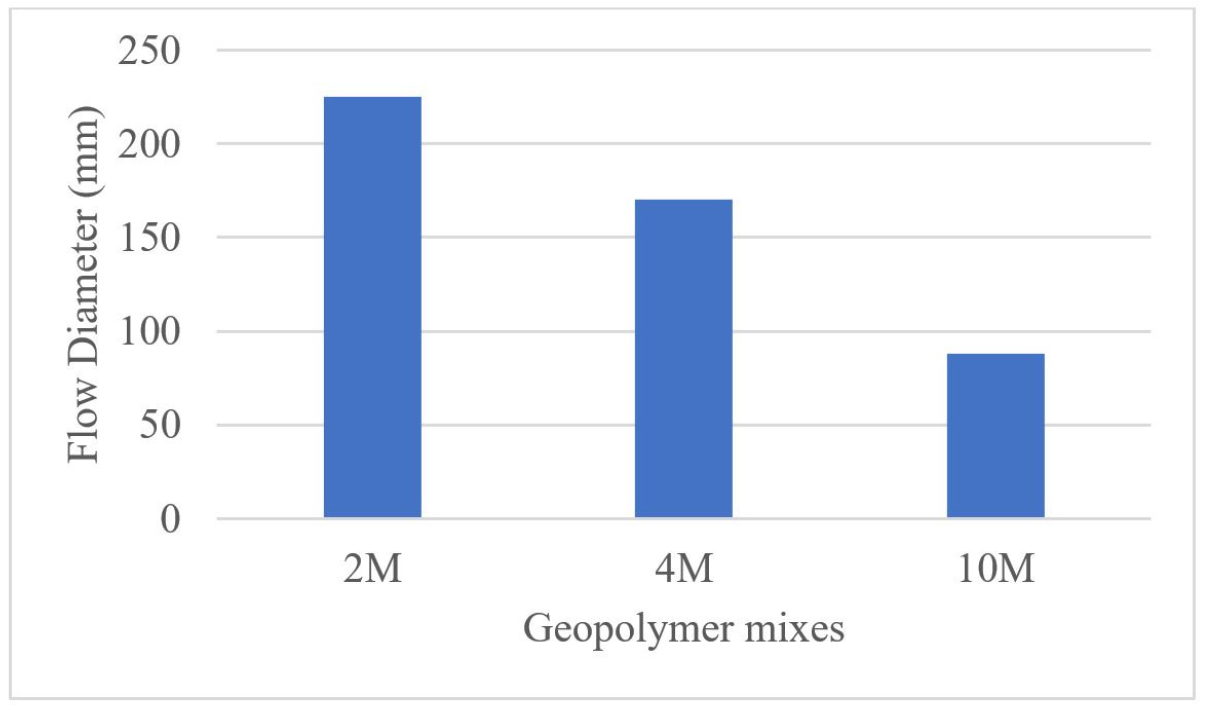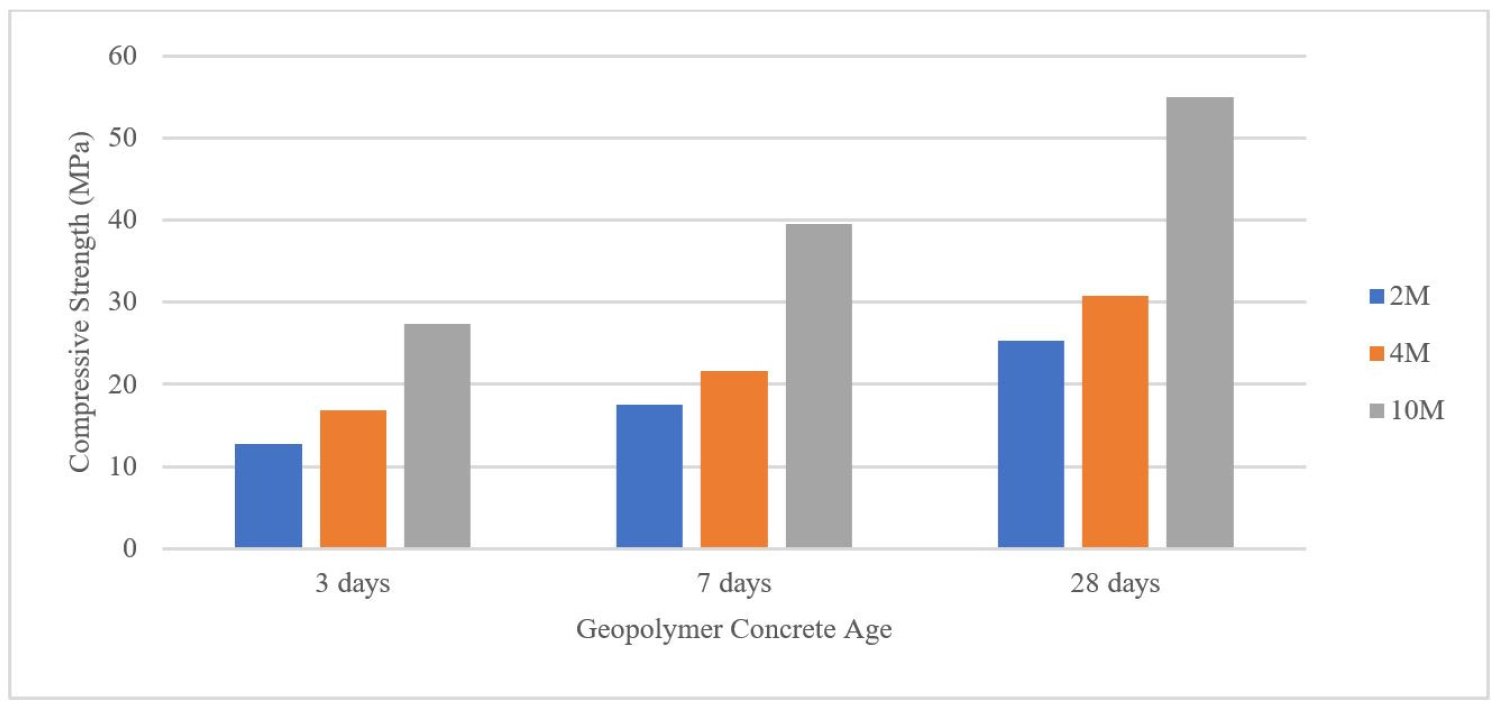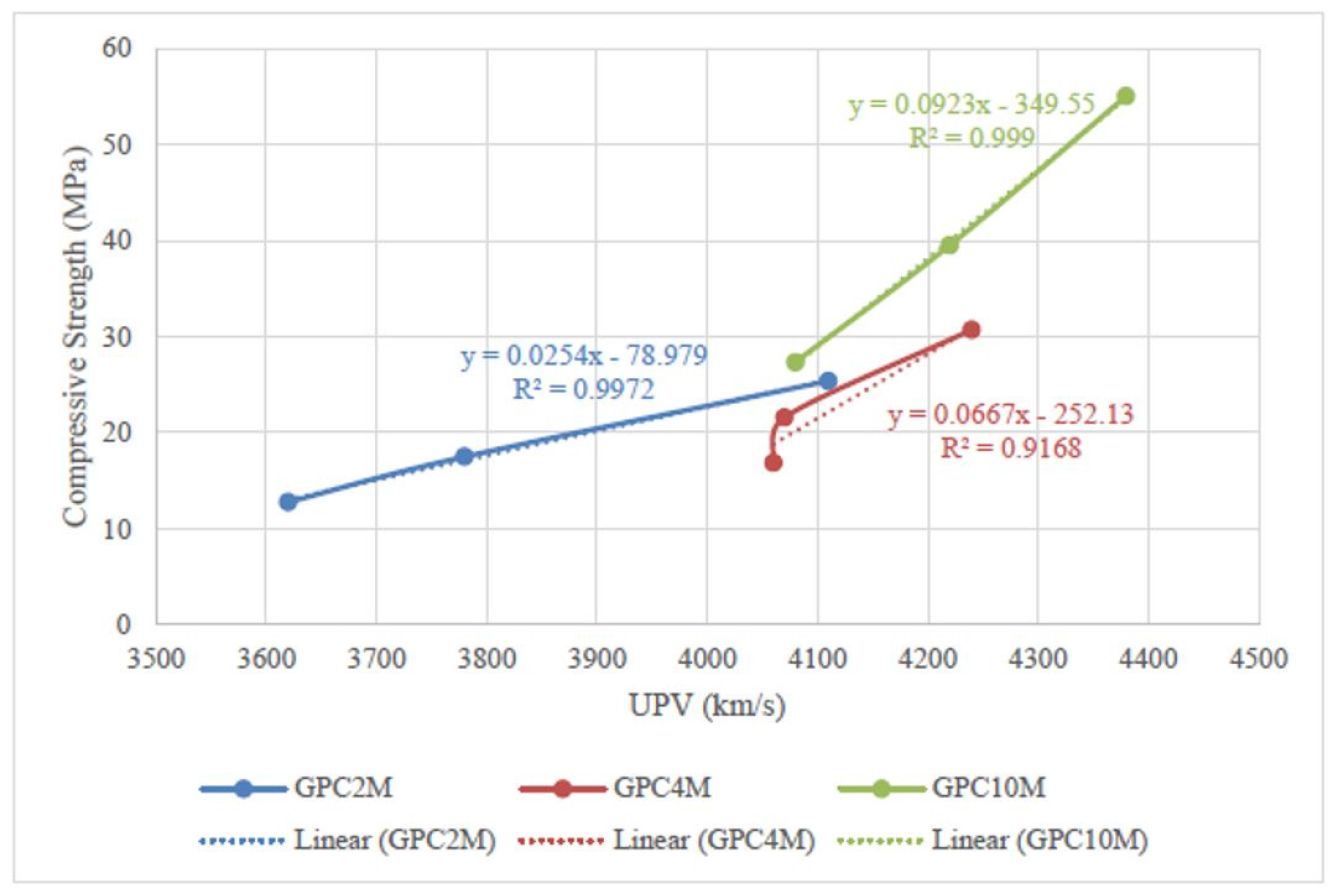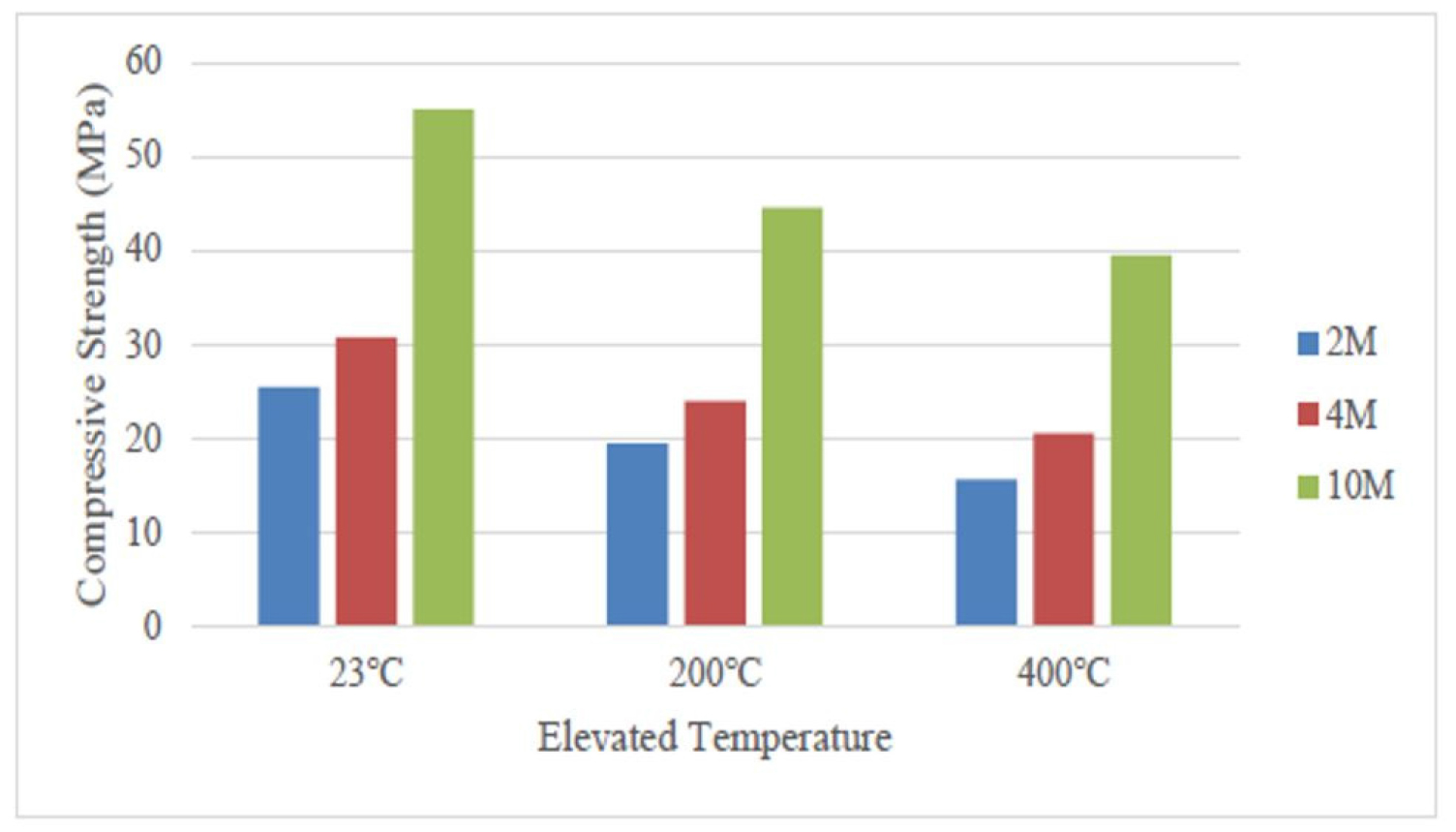Introduction
Methodology
Material
Mix Design
Test Methods
Results and Discussion
X-Ray Fluorescence (XRF) Test
Flow test
Ultrasonic Pulse Velocity Test
Compressive Strength Test
Relationship between Ultrasonic Pulse Velocity and Compressive Strength
Elevated Temperature
Conclusion
Introduction
Although concrete has many advantages in the construction industry, the production of cement emits tons of carbon dioxide (CO2) every year. The carbon dioxide that emitted from the cement production is around 1.5 Gt in 2018 and cumulative emissions from 1928 to 2018 were around 38.3 Gt CO2[1]. In order to reduce the usage of Portland cement, the development of alternative binder has been strongly motivated to develop more sustainable construction solution [2]. An alternative concrete called “Geopolymer concrete” was introduced by Davidovits in 1978 and has been undergoes much research in the past few decades [3, 4]. The term ‘geopolymer’ is due to a chemical process - geopolymerization occur during the production of this concrete.
Geopolymerization is a process where aluminosilicate raw material is transformed to a complex polymer structure undergoes several chemical reactions [5]. Generally, there are 4 steps of chemical reaction to produce a geopolymer concrete, which are dissolution, oligomerisation, polycondensation and hardening [3]. The past researchers successfully produced a geopolymer concrete using different type of aluminosilicate raw material with different chemical composition such as Class F fly ash [6], Class C fly ash [7, 8], ground granulated blast-furnace slag [6], kaolin [9] and silica fume [7]. Besides, it is recorded that the increase of Na2SiO3 is helpful towards strength development as the compressive strength seems to be directly proportional to Si content [10]. The high pH which generated from hydrolysis of Na2SiO3 is able to break the glassy chain at the fly ash surface promoting the active reaction of the internal silica and alumina [11].
Furthermore, concrete is known to have low heat conductivity and the material itself is non-combustible [12]. Although in most cases concrete do perform well under fire without having any extra protection, spalling effect may occur when having certain level of direct fire exposure. Such spalling will lead to cracking of concrete surface or concrete cover. These cracks will cause an opening for the direct exposure of steel reinforcement in the concrete that result in loss of its loading capacity [12]. On the other hand, recent studies showed geopolymer concrete has better fire endurance compared to ordinary concrete in term of compressive strength and bonding strength [13].
In the results from Zhang et al. [12] shows reduction in compression and spalling behaviour can be observed from the specimen surface. The main or primary factor contribute to this phenomenon is the moisture content in the specimen causing thermally induced explosive spalling; the higher the moisture content, the higher the tendency of spalling [12]. The temperature-induced dihydroxylation will damage the microstructure of geopolymer concrete [13]. Nuaklong et al. [14] exposed the specimen in direct fire to investigate the performance of geopolymer concrete. Findings reported that the degradation performance of geopolymer concrete after expose to heat is undeniable. The reason of such degradation is due to the sudden rise of vapor pressure inside the concrete causing spalling of concrete [15]. Besides, the restraining effect of aggregates will also cause spalling of concrete [14]. These spalling and cracks in concrete will damage the internal microstructure of concrete which further causing the decrease in strength of concrete [13].
In addition, the high molarity of alkaline solution is often used to produce geopolymer concrete but the cost of chemical alkaline solution is expansive and highly corrosive to the reinforcement of reinforced concrete [16]. The high molarity of alkaline solution also triggers unpleasant effects to the environmental, especially groundwater. However, there are limited number of research on the use of low alkaline solution in geopolymer concrete production. Therefore, there is a need to study the strength properties of fly ash-based geopolymer concrete made with low molarity alkaline solution and the effect on the elevated temperature.
Methodology
Material
Class C fly ash which obtained from coal power plant located in Negeri Sembilan, Malaysia is used as the main binder of the geopolymer concrete. River sand with maximum size 5 mm is used as fine aggregates whereas granite with maximum size 10 mm is used as coarse aggregates.
Mix Design
Alkaline solution with 2, 4, and 10 M sodium hydroxide were used in this research. 2M and 4M are classified as low molarity while 10M sodium hydroxide which was used as reference mix is classified as high molarity. The sodium hydroxide to sodium silicate ratio is 1:2.5. The ratio of alkaline solution to fly ash is 0.45 and binder to aggregate ratio is 1:3. Mix design of this research is determined based on the previous research and studies done by Abdullah et al. [17, 18], Darvish et al. [19], Priyanka et al. [20], Liu et al. [21], Abbas et al. [22], Khalil et al. [23], Ameri et al. [24, 25], Ming et al. [26], Mohseni et al. [27], Nasser et al. [28], Swaminathan et al. [29] and Ariffin et al. [30]. The samples are casted in 100 × 100 × 100 mm mould and cured for 3 days, 7 days, and 28 days under room temperature. Table 1 shows the mix design used in this research.
Table 1
Mix design for the study
| Mix ID |
FA (kg/m3) |
2M NaOH |
4M NaOH |
10M NaOH | Na2SiO3 |
Coarse Agg. (kg/m3) |
Fine Agg. (kg/m3) |
5% SP |
| GPC2M | 500 | 65 | - | - | 160 | 1126 | 483 | 25 |
| GPC4M | 500 | - | 65 | - | 160 | 1126 | 483 | 25 |
| GPC10M | 500 | - | - | 65 | 160 | 1126 | 483 | 25 |
Test Methods
The testing method for Ultrasonic Pulse Velocity (UPV) test was adopted from ASTM C 597 [31]. The standard used for the determination of compressive strength of concrete cubes is BS 1881: Part 116, [32] while the test method of elevated temperature test for geopolymer concrete is adopted from Zhang et al. [12]. The specimens were tested at 200 and 400°C temperature for 1 hour. Microstructure tests such as X-Ray Fluorescence (XRF) also had been carried out to determine the chemical composition of raw materials. The specimens cured in air were tested for 3, 7 and 28 days for those tests. Three specimens were tested to obtain the average value for each test condition.
Results and Discussion
X-Ray Fluorescence (XRF) Test
X-rays fluorescence spectroscopy to study the chemical composition in the binder which is fly ash. As shown in the results that summarised in Table 2, it was found that the silica content of fly ash is 32.7% which is the main component of fly ash. Obviously, the existence of higher silica content stimulates the geopolymerization reaction to produce extra calcium-alumino-silicate-hydrate gels thus makes the geopolymer more durable and denser [33]. According to ASTM Standards C618 [34], fly ash can be categorized as Class C because the total SiO2, Al2O3 and Fe2O3 contents are more than 50%.
Table 2
Chemical composition of fly ash
| Chemical composition (%) | Fly Ash |
| SiO2 | 32.7 |
| Al2O3 | 12.7 |
| Fe2O3 | 12.8 |
| CaO | 24.3 |
| MgO | 7.42 |
| K2O | 1.40 |
| TiO2 | 0.811 |
| LOI | 0.27 |
Flow test
The workability of geopolymer was measured by flow test. The comparison of flow diameter between geopolymer concrete mixes casted with different molarity of alkaline solution is shown in Figure 1. The measured flow diameter for geopolymer concrete mixes casted with 2M, 4M and 10M NaOH were 225 mm, 170 mm and 88 mm, respectively. Geopolymer concrete mixes casted with 10M NaOH shows the lowest workability compared to 2M and 4M NaOH. This is due to the higher viscosity in 10M NaOH which reduce the flow of the composite compared to 2M and 4M NaOH. As the concentration of sodium hydroxide solution increases, the viscosity of alkaline activator solution also increases. Thus, the workability of geopolymer concrete mix decreases.
Ultrasonic Pulse Velocity Test
The UPV results of geopolymer concrete cubes made with 2M, 4M and 10M NaOH in 3 days, 7 days and 28 days are shown in Figure 2. The results have shown that the increase of molarity of NaOH in alkaline solution improves the performance of UPV values in the geopolymer concrete samples at all ages. The percentage difference of UPV result between mix geopolymer with 2M and 4M alkaline solution at 3 days, 7 days and 28 days are 12.2%, 7.7% and 3.2%, respectively. Whereas the control mix geopolymer concrete with 10M alkaline solution shows the highest UPV result in all age. This phenomenon occurs because alkalinity will directly affect the development of geopolymer structure in the concrete. The higher the pH, the higher the ability to break the glassy chain at the fly ash surface promoting the active reaction of the internal silica and alumina [11]. The role of Na+ in geopolymerization process is to harden the geopolymer structure. Therefore, higher molarity of NaOH increase the concentration of Na+ and OH- in the geopolymer mixes. This lead to the higher reactivity of silica and alumina in geopolymerization process thus produce denser geopolymer structure. Besides, the pattern of the strength comparison between mixes can be predicted based on the UPV values.
Compressive Strength Test
Figure 3 shows the effect of different molarity alkaline solution on the compressive strength of geopolymer concrete mixes. From the result, it is shown that the ultimate strength of geopolymer concrete made with 2M and 4M is comparable with normal strength concrete while the ultimate strength of geopolymer concrete made with 10M NaOH produce up to 55 MPa. The percentage difference between geopolymer concrete made with 2M and geopolymer concrete made with 4M at 3, 7 and 28 days are 31%, 23% and 21%, respectively. However, the control mix geopolymer concrete with 10M alkaline solution shows the highest average compressive strength at 3 days, 7 days and 28 days. Similar to UPV values, higher molarity of NaOH produce a higher alkalinity alkaline solution with high concentration of Na+ and Na/Si ratio. In geopolymerization process, Na+ has the role in the hardening stage. Therefore, higher Na+ concentration will produce higher compressive strength of geopolymer concrete [35].
Relationship between Ultrasonic Pulse Velocity and Compressive Strength
Table 3 and Figure 4 shows the relationship between UPV and compressive strength of fly ash-based geopolymer concrete. From Figure 3, the result shows that the gradient for the linear trend line of all three mixes give a positive gradient. This is probably due to the good quality of geopolymer concrete with less porosity which increase the compressive strength of the geopolymer concrete. When the molarity of alkaline solution increases, the value of gradient increases. This is because when the molarity of alkaline increases, the alkalinity of the alkaline solution increases providing higher alkaline condition for the alumina and silica to undergo dissolution in geopolymerization process. This will result in a denser geopolymer structure and decrease in porosity in the concrete and finally gives a higher compressive strength.
Table 3
Relationship between UPV and compressive strength
Elevated Temperature
The mean compressive strength of fly ash-based geopolymer concrete made with 2M, 4M and 10M NaOH under heat exposure are shown in Figure 5. From the result of geopolymer concrete under 2M alkaline solution, the residual strength of the sample shows a reduction till 76.6% after heating up to 200°C for 1 hour and the compressive strength remain 61.4% after 400°C of heating for 1 hour. However, for 200°C temperature, the residual strength for geopolymer concretes under 4M and 10M alkaline solution are 77.8% and 81.0% respectively. The residual strength for both mixes after 400°C exposures for 1 hour remain 66.9% and 71.7%, respectively. Therefore, it can be seen that the higher the alkalinity of alkaline solution, the lesser the strength reduction and the better the fire resistance under elevated temperature. The reason of such reduction of strength is mainly due to the thermal shock and the difference of thermal expansion between geopolymer matric and the aggregates [15]. The difference will cause cracks and destroy the bonding between geopolymer matrix and aggregates resulting damaging the geopolymer concrete. Besides, the thermal induced explosive spalling or thermal shock will also cause internal cracks and cracks at the surface of the concrete. These cracks will damage the internal structure of the concrete result in the reduction of compressive strength.
Conclusion
The compressive strength of fly ash-based geopolymer concrete made with low molarity alkaline solution was determined and the effect of elevated temperature on geopolymer concrete made with low molarity alkaline solution was investigated. The use of 4M sodium hydroxide to produce fly ash-based geopolymer concrete contribute a higher compressive strength compared to fly ash-based geopolymer concrete made with 2M sodium hydroxide. Although the control mix with 10M alkaline solution has the highest strength, but the target of the study is to investigate the practicality of using low alkalinity alkaline solution to produce geopolymer concrete in construction industry. Therefore, fly ash-based geopolymer concrete made with 4M sodium hydroxide has contributed a sufficient strength to produce a structural element with strength application of 30 MPa while as for 2M sodium hydroxide, the geopolymer concrete has shown a comparable strength with Grade 25 concrete. Same goes to elevated temperature test. Fly ash-based geopolymer concrete made with 4M NaOH shows a better performance in elevated temperature test as compared to fly ash-based geopolymer concrete made with 2M NaOH whereas the fly ash-based geopolymer concrete made with 10M NaOH shows the best performance in elevated temperature test. This study has a great potential for construction industry Malaysia to implement geopolymer concrete in non-structural purposes in the future. However, further studies on geopolymer concrete shall be conducted to increase the practicability of geopolymer concrete in construction industry.









